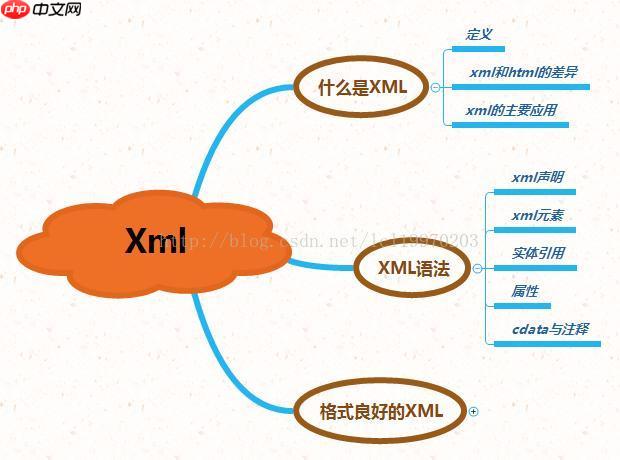处理指令(pi)是xml中用于向解析器或应用程序传递指令的特殊标记,格式为<?target data?>,其中target指明目标应用,data为具体指令内容;1. dom解析中通过检查节点类型为node.processing_instruction_node来提取pi的target和data;2. sax解析需重写processinginstruction方法,在事件触发时获取target和data;3. xpath可通过//processing-instruction()表达式查询所有pi节点并遍历获取其内容;4. stax使用xmlstreamreader在流式读取时通过eventtype判断pi并调用getpitarget和getpidata获取信息;pi常用于指定样式表、嵌入脚本或传递自定义配置,与仅作说明的注释不同,pi是供程序执行的指令,应谨慎使用以避免代码注入或xxe等安全风险,建议对数据严格验证并避免直接执行代码,最终确保pi的合理与安全应用。

XML中的处理指令(Processing Instruction,简称PI)本质上是XML文档中嵌入的、用于传递信息给应用程序的指令。它们不是文档内容的一部分,而是指示XML解析器或应用程序如何处理文档的特殊标记。可以理解为给解析器或应用程序的“小纸条”。
Processing Instruction的基本格式是
<?target data?>
target
data
解决方案:
处理指令的解析方式取决于你使用的XML解析器和编程语言。这里以几种常见的场景为例:
1. DOM解析 (Document Object Model)
DOM解析器会将XML文档解析成一个树形结构,你可以通过遍历这个树来找到处理指令节点。
import org.w3c.dom.*;
import javax.xml.parsers.*;
import java.io.*;
public class PIExample {
public static void main(String[] args) {
try {
File xmlFile = new File("your_xml_file.xml");
DocumentBuilderFactory dbFactory = DocumentBuilderFactory.newInstance();
DocumentBuilder dBuilder = dbFactory.newDocumentBuilder();
Document doc = dBuilder.parse(xmlFile);
doc.getDocumentElement().normalize();
NodeList nodeList = doc.getChildNodes(); // 获取根节点下的所有节点
for (int i = 0; i < nodeList.getLength(); i++) {
Node node = nodeList.item(i);
if (node.getNodeType() == Node.PROCESSING_INSTRUCTION_NODE) {
ProcessingInstruction pi = (ProcessingInstruction) node;
System.out.println("Target: " + pi.getTarget());
System.out.println("Data: " + pi.getData());
}
}
} catch (Exception e) {
e.printStackTrace();
}
}
}import xml.dom.minidom
dom = xml.dom.minidom.parse("your_xml_file.xml")
for node in dom.childNodes:
if node.nodeType == xml.dom.Node.PROCESSING_INSTRUCTION_NODE:
print("Target:", node.target)
print("Data:", node.data)2. SAX解析 (Simple API for XML)
SAX解析器是事件驱动的,它会逐个读取XML文档的元素,并在遇到特定的事件时触发相应的回调函数。你需要实现
org.xml.sax.helpers.DefaultHandler
processingInstruction()
import org.xml.sax.*;
import org.xml.sax.helpers.*;
import javax.xml.parsers.*;
import java.io.*;
public class SAXPIExample extends DefaultHandler {
@Override
public void processingInstruction(String target, String data) throws SAXException {
System.out.println("Processing Instruction - Target: " + target + ", Data: " + data);
}
public static void main(String[] args) {
try {
SAXParserFactory factory = SAXParserFactory.newInstance();
SAXParser saxParser = factory.newSAXParser();
SAXPIExample handler = new SAXPIExample();
saxParser.parse(new File("your_xml_file.xml"), handler);
} catch (Exception e) {
e.printStackTrace();
}
}
}3. XPath
XPath可以用来查询XML文档中的节点,包括处理指令。
import javax.xml.parsers.DocumentBuilderFactory;
import javax.xml.parsers.DocumentBuilder;
import org.w3c.dom.Document;
import javax.xml.xpath.*;
import java.io.File;
public class XPathPIExample {
public static void main(String[] args) {
try {
File xmlFile = new File("your_xml_file.xml");
DocumentBuilderFactory factory = DocumentBuilderFactory.newInstance();
DocumentBuilder builder = factory.newDocumentBuilder();
Document doc = builder.parse(xmlFile);
XPathFactory xPathfactory = XPathFactory.newInstance();
XPath xpath = xPathfactory.newXPath();
XPathExpression expr = xpath.compile("//processing-instruction()"); // 查询所有处理指令
Object result = expr.evaluate(doc, XPathConstants.NODESET);
NodeList nodes = (NodeList) result;
for (int i = 0; i < nodes.getLength(); i++) {
org.w3c.dom.Node node = nodes.item(i);
ProcessingInstruction pi = (ProcessingInstruction) node;
System.out.println("Target: " + pi.getTarget());
System.out.println("Data: " + pi.getData());
}
} catch (Exception e) {
e.printStackTrace();
}
}
}4. StAX (Streaming API for XML)
StAX 提供了更细粒度的XML解析控制,允许你以流的方式读取XML文档。
import javax.xml.stream.*;
import java.io.*;
public class StAXPIExample {
public static void main(String[] args) {
try {
XMLInputFactory factory = XMLInputFactory.newInstance();
XMLStreamReader reader = factory.createXMLStreamReader(new FileInputStream("your_xml_file.xml"));
while (reader.hasNext()) {
int eventType = reader.next();
if (eventType == XMLStreamConstants.PROCESSING_INSTRUCTION) {
System.out.println("Target: " + reader.getPITarget());
System.out.println("Data: " + reader.getPIData());
}
}
} catch (Exception e) {
e.printStackTrace();
}
}
}处理指令的用途相当广泛,取决于具体的应用场景。一些常见的例子包括:
<?xml-stylesheet type="text/xsl" href="style.xsl"?>
style.xsl
<?php echo 'Hello World'; ?>
虽然处理指令和注释都可以嵌入在XML文档中,但它们有着本质的区别:
<!-- comment -->
换句话说,注释是给人看的笔记,而处理指令是给机器看的命令。
在以下情况下,可以考虑使用处理指令:
但是,需要谨慎使用处理指令。过度使用处理指令会使XML文档变得复杂和难以维护。在许多情况下,使用XML属性或元素来传递信息可能更加合适。
由于处理指令可以包含任意数据,因此在使用处理指令时需要注意安全问题。
为了避免这些安全问题,你应该:
总而言之,处理指令是XML中一种强大的机制,可以用于向应用程序传递指令。但是,你需要谨慎使用处理指令,并注意安全问题。
以上就是XML中的处理指令(Processing Instruction)是什么?怎么解析?的详细内容,更多请关注php中文网其它相关文章!

每个人都需要一台速度更快、更稳定的 PC。随着时间的推移,垃圾文件、旧注册表数据和不必要的后台进程会占用资源并降低性能。幸运的是,许多工具可以让 Windows 保持平稳运行。

Copyright 2014-2025 https://www.php.cn/ All Rights Reserved | php.cn | 湘ICP备2023035733号